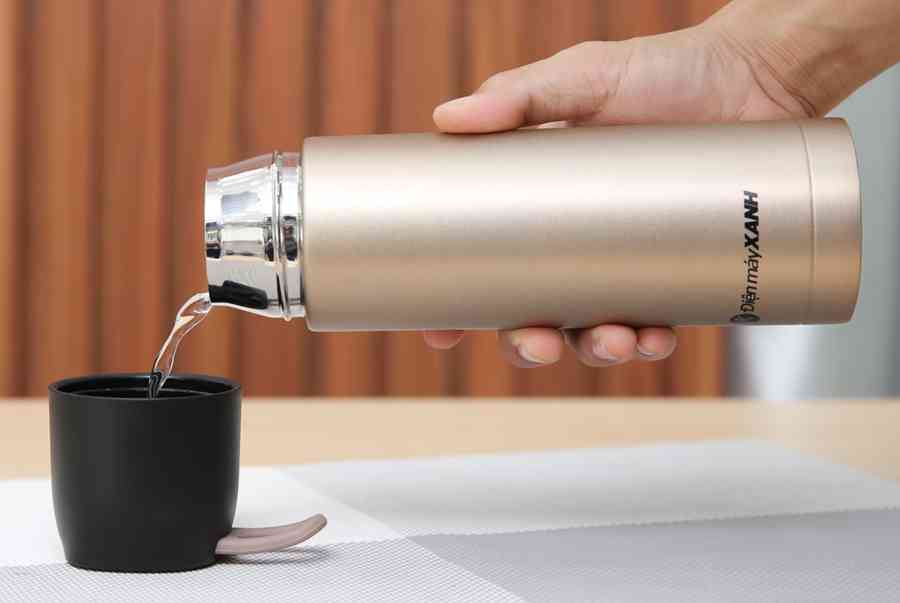ASUS TUF Gaming A17 FA706 review (FA706II – Ryzen 7 4800H, GTX 1650 Ti)
This is our detailed review of the Asus TUF Gaming A17 FA706II, the base-tier model of the 2020 TUF Gaming A17 series based on AMD Ryzen 4000 H and Nvidia GTX hardware.
The FA706 is the slightly larger 17-inch version of the more compact FA506 A15 series, which comes with a 15-inch screen. The two are otherwise similar in many ways, but with some subtle differences that you should be aware of when shopping between the two.
We’ll compare them in a different article, as this focuses exclusively on this 17-inch FA706II. The laptop follows-up on the popular TUF Gaming FX705 from 2019 and is more than just a hardware update, as it also improves on aspects such as design, ergonomics, and features, alongside the expected boost in performance and efficiency.
We’ve spent the last few weeks with an early version of this notebook and gathered out thoughts down below, with the strong point and the quirks. Based on our experiences and the available review guides, this review unit works much as you should expect from the retail units you’ll be able to find in stores, although certain aspects might get polished with later software updates.
Specs as reviewed – ASUS TUF Gaming A17 FA706II
ASUS TUF Gaming A17 FA706II
Display
17.3-inch, 1920 x 1080 px IPS 120 Hz, 16:9, non-touch, matte, AU Optronics B173HAN04.7
Processor
AMD Ryzen 7 4800H, 8C/16T
Video
AMD Radeon Vega 8 + Nvidia GeForce GTX 1650 Ti 50W 4GB GDDR6 (with Nvidia 445.87)
Memory
32 GB DDR4 3200 MHz (2x DIMMs)
Storage
1x M.2 PCI x4 slot (1 TB Intel 660p SSDPEKNW010T8), 2.5″ HDD bay on 48Wh battery model
Connectivity
Gigabit LAN (Realtek RTL8168/8111), Wireless 5 (Realtek 8822CE) 2×2, Bluetooth 5.0
Ports
2x USB-A 3.2, 1x USB-A 2.0, 1x USB-C gen 2 with DP and data, HDMI 2.0b, LAN, headphone/mic, Kensington Lock
Battery
48 Wh, 180 W power adapter
Size
399 mm or 15.70” (w) x 269 mm or 10.59” (d) x 25.2 mm or .99” (h)
Weight
2.45 kg (5.4 lbs), .65 kg (1.1 lbs) power brick and cables, EU version
Extras
single-zone RGB backlit keyboard, webcam, stereo speakers
This is an oddly specced configuration of the TUF Gaming A17 FA706, as it pairs the higher-end Ryzen 7 processor with the base level GTX 1650 Ti graphics chip, as well as 32 GB of RAM and 1 TB of storage. Based on what I’m seeing right now, most retail versions are either Ryzen 5 4600H + GTX 1650 Ti + 8/16 GB of RAM + 512 GB/1 TB storage (sold as TUF Gaming FA706II) or Ryzen 7 4800H + GTX 1660 Ti + 16 GB of RAM + 512 GB storage (as TUF Gaming FA706IU).
However, configurations vary between regions, so if you’re looking for a computer that can excel in CPU demanding loads, don’t necessarily care about GPU performance and would prefer not to spend extra for an IU variant, this sort of configuration can make sense.
Design and construction
Build wise the TUF Gaming FA706 is an oversized version of the 15-inch variant, with the same design and construction particularities.
Compared to the previous generation FX705, the FA706 is a little bit smaller and lighter, sturdier built and cleaner in terms of looks. The laptop still meets MIL-STD-810H reliability standards and still gets a plastic chassis and interior deck, but it’s been reinforced and feels stronger and better made now. On top of that, the lid-cover is all metal and available in two versions: a simple Fortress Gray variant, the one we have here, as well as a more complex Bonfire Black alternative.
Some small updates further impact the laptop’s ergonomics. The front lip and corners are still blunt and comfortable on the wrists, and the screen still doesn’t lean back past 145 degrees. However, the hinges are a little smoother and allow to push up the display with a single hand, there’s a notch at the top of the screen to grab it from, and the entire bottom has been redesigned. It now includes larger and grippier rubber feet, as well as larger speaker cuts and re-thought air intake cuts.
Cooling is not much of a problem in this configuration that only gets a 50W GPU, but the higher tier 1660Ti will benefit from the changes. Worth noting that there are also internal design differences between the two variants, as this GTX 1650 Ti gets a simpler thermal module, which is still capable of keeping the hardware in check. We’ll get to this down below.

On top of that, I should also mention that the hot air is only blown our through the back cutouts on this FA706II variant, and there’s no extra output grill on the right side, like on the more powerful versions. That’s good, as it means hot air is no longer blown into your mouse.
Finally, the TUF FA706 also gets a slight IO redesign. There’s now an USB-A slot on the left side as well, while most of the ports are still lined on the right, where you’ll find the PSU at the back, followed by LAN and HDMI, two USB-A slots and an USB-C port with support for data and DP1.4, but not for charging or Thunderbolt 3. That’s a novelty for the TUF lineup, as the previous models lacked any sort of USB-C port.
Overall, just like I concluded in our review of the smaller 15-inch FA506 series, this TUF Gaming FA706 might not seem like a major update over the FX705s, but it actually improves on multiple small details that add up for an overall better product.
Keyboard and trackpad
The keyboard is the exact same one implemented on the TUF FA506 and only a slight variation from what was previously included with the FX705 series. The layout is simple and practical, with a well-sized and spaced main deck of keys, a slightly cramped NumPad section and redesigned arrows, now smaller, but better spaced out than in the past.
The typing experience is still only OK, not bad, not great either, at least for someone like me who’s more accustomed to shorter-stroke keyboards. These keys feel soft to the touch and travel 1.8 mm into the chassis, but they’re also somewhat spongy and imprecise, the kind of feedback that makes it hard to tell if a press was properly registered, thus impacting both accuracy and typing speed.
Of course, we all have our preferences when it comes to typing feedback, and I’d reckon this will do fine for most of you once you get used to it. For me, though, there are nicer typers out there.
I should also mention that the keys are RGB backlit, with a single-zone and the ability to control the color and some effects in the included AURA software. The illumination is fairly uniform on the model and the LEDs get bright on the higher setting, plus the light doesn’t creep as badly from underneath the keycaps as I was expecting from a taller implementation such as this one.
For mouse, Asus went with an immovable plastic touchpad and dedicated click buttons on this generation, a welcomed redesign of the clickpad implemented on the FX705s. It’s rather small for this day and age, but it works alright. It’s an Elan implementation with Precision drivers and it handled everyday use, taps, and gestures just fine. The click buttons are also very nice, smooth and quiet, but I found that the surface still rattles when tapped firmly. Not as loudly as on the FX705s, though.
Finally, there are no biometrics on this laptop.
Screen
Unlike the smaller TUF A15 FA506, this 17-inch model does not get a panel bump with the new generation. Instead, it still only tops at a 120 Hz IPS-level panel, the AU Optronics 173HAN04.7 other OEMs have been using on entry-level gaming notebooks in the past, such as the MSI GL75. For what is worth, though, there’s also a 144 Hz variation of this panel with slightly improved features that I would have expected here, especially since others have been offering them in similar tier products for a while now.
As it is, this panel is OK for indoor use and gaming and doesn’t use PWM, but it’s also rather dim and washed out, so don’t expect rich colors or plan to use this in bright environments. Nonetheless, I would have expected an upgraded panel on this FA706, especially when the 15-inch variant got one.
Here’s what we got on our sample with a Sypder4 sensor.
- Panel HardwareID: AU Optronics AUO479D (B173HAN04.7);
- Coverage: 58.6% sRGB, 40.8% AdobeRGB, 42.0% DCI P3;
- Measured gamma: 2.08;
- Max brightness in the middle of the screen: 274 cd/m2 on power;
- Contrast at max brightness: 1233:1;
- White point: 6500 K;
- Black on max brightness: 0.22 cd/m2;
- PWM: No.

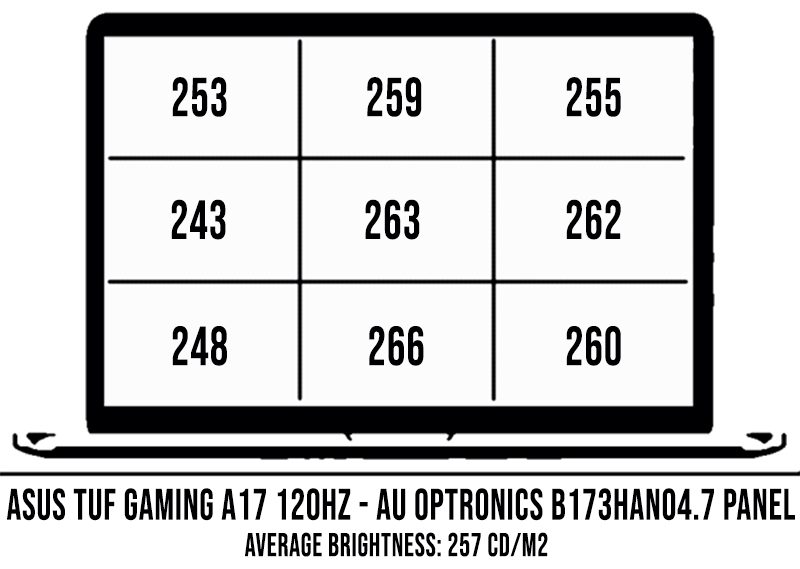
This is also well calibrated out of the box, but our tests did notice a fairly significant drop on DeltaE variation in the left quadrants of this sample. I doubt that’s going to weigh much in your decision though, as this sort of panel is not something you’d want to use for color-accurate work to begin with.
Oh, and keep in mind there’s also a 60 Hz screen option available for the TUF Gaming FA706, which could make its way into some of the base-level configurations. I’d reckon it’s the same panel from the TUF Gaming FX705, so actually slightly brighter than the 120 Hz version, but otherwise still washed out. Plus, of course, slower and a worse option for gaming.
Hardware and performance
Our test model is a mid-ranged Asus TUF Gaming FA706II configuration, with the Ryzen 7 4800H processor, 32 GB of RAM in dual-channel, an M.2 PCIe x4 SSD for storage, and dual graphics, with the Nvidia GeForce GTX 1650Ti 4GB dGPU, alongside the updated Radeon Vega 8 iGPU within the AMD processor.
Keep in mind this is an early model running on the software available as of Mid-April 2020 (BIOS 302, Armoury Crate 2.6.14, GeForce 445.87 drivers – more recent versions did not install), thus certain aspects might change with future software updates. Nonetheless, our results are in line with the provided AMD/ASUS guidelines, so they should also be mostly what you’ll get with the retail models.
Just like with the 15-inch model, the Ryzen 4000 H platform is the major novelty here, and the Ryzen 7 4800H performed flawlessly in our tests inside this larger chassis. It’s an 8C/16T processor with various improvements over the previous Ryzen 7 3750H APU, as well as support for faster RAM and storage, thus it smokes its predecessor across the board. In fact, it smoked all the existing Mobile platforms in most cases, including the Intel i9s, but we’ll further get in-depth on that in a separate comparison.
Before we move onto our tests I should mention that this configuration gets 32 GB of DDR4 3200 MHz RAM in dual-channel. Lower-tier configurations might only ship with a single RAM stock in single-channel, and you’ll want to upgrade that, as single-channel memory takes a fairly significant toll in games, with the more recent Windows 10 versions.
Finally, the Nvidia GTX 1650Ti GPU is a new chip meant for budget laptops as a step-up from the existing GTX 1650 available on 2019 entry-level gaming models. It’s actually clocked slightly lower than the GTX 1650, but gets GDDR6 memory, so is roughly 5-15% faster in GPU loads and games. We’ll compare the two in a future article.
That aside, the CPU and GPU are soldered on the motherboard and non-upgradeable, but the RAM and storage can be accessed and upgraded. For that, you’ll have to remove the back-panel, hold in place by a handful of screws. Careful they’re of different sizes, so make sure you put them back the right way. Also, keep in mind that the bottom-right screw is a non-removable pop-up screw designed to make it easier for you to take out that back panel. You’ll understand what I mean when you get to it.
Inside you’ll notice that there’s a fair bit of unused space on this variant, as our configuration gets the smaller 48 Wh battery and an HDD cage, plus only a single M.2 SSD slot. The HDD connector is included, but taped onto the cage and not connected.
If given the option, I’df suggest going with the larger battery model that ditches the HDD cage for a 90 Wh battery and an extra M.2 SSD slot. Speaking of, our review unit came with a fairly slow Intel 660p QLC drive. It’s hooked up via a PCIe x4 connection, so upgrades might make sense here. However, keep in mind that the included drive varies between regions, so contacting your local supplier is pretty much the only way to tell for sure what you’ll end up with on your unit.
Moving on, before we finally get to talk about performance on this FA706, I have to mention that Asus offers three power profiles in the included Armoury Crate, meant to juggle with speed, thermals and noise according to your expectations:
- Silent – prioritizes lower fan-noise and reduces CPU/GPU speeds and power;
- Performance – balanced profile with stock CPU/GPU settings;
- Turbo – High-Performance profile with increased CPU power allocation and overclocked GPU.
Turbo is only available with the laptop plugged-in, and is meant for gaming and other demanding loads. Performance is a jack-of-all-trade and what I’d recommend for daily multitasking and perhaps some older games, while Silent is great for video and light-use on battery, but makes the laptop choppy with multitasking.
With that in mind, here’s what to expect from this laptop with daily use on Silent (Youtube, Netflix, Typing) and Performance (Browsing).
On to more demanding tasks, we’ll start by testing the CPU’s performance in taxing loads, and we do that by running Cinebench R15 for 10+ times in a loop, with 2-3 seconds delay between each run, with the laptop on Turbo. Right now there’s no way to undervolt or tweak this CPU, so the Turbo Stock profile is the best you’re going to get here.
On this profile, the Ryzen 7 4800H processor settles for clock speeds of 3.7+ GHz, temperatures of around 78-80 degrees Celsius and scores of 1800+ points, with a constant TDP of above 54W.
Switching over to Performance drops the power to around 35W in sustained loads after a few runs, with a decrease in scores, temperatures, and noise levels. Further switching to Silent lowers the TDP even more, to around 20W. Finally, on battery, the power is limited at only 12W in the Performance mode (Turbo is disabled in this case), which is abnormally low and should be increased with a future BIOS update. Details below.
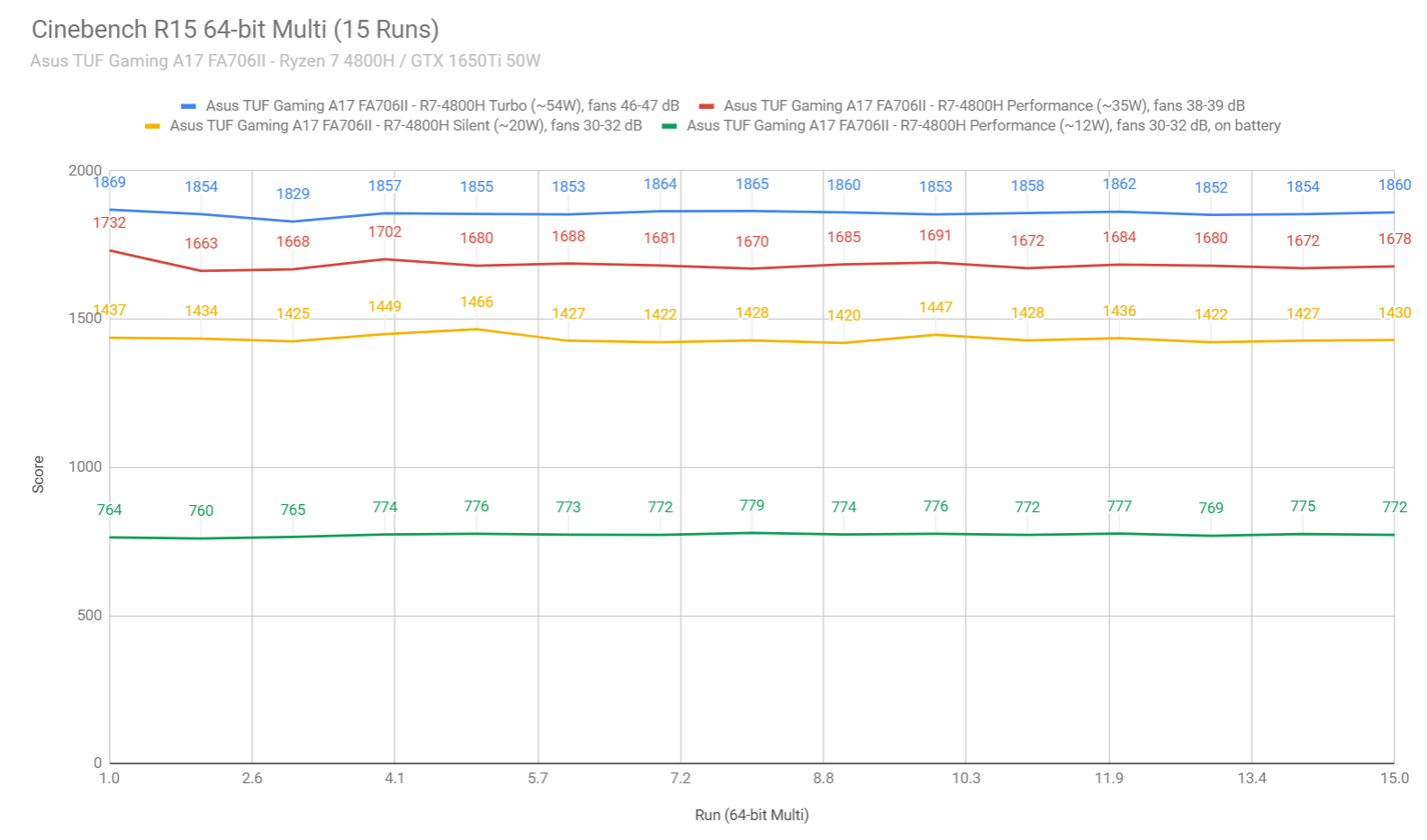
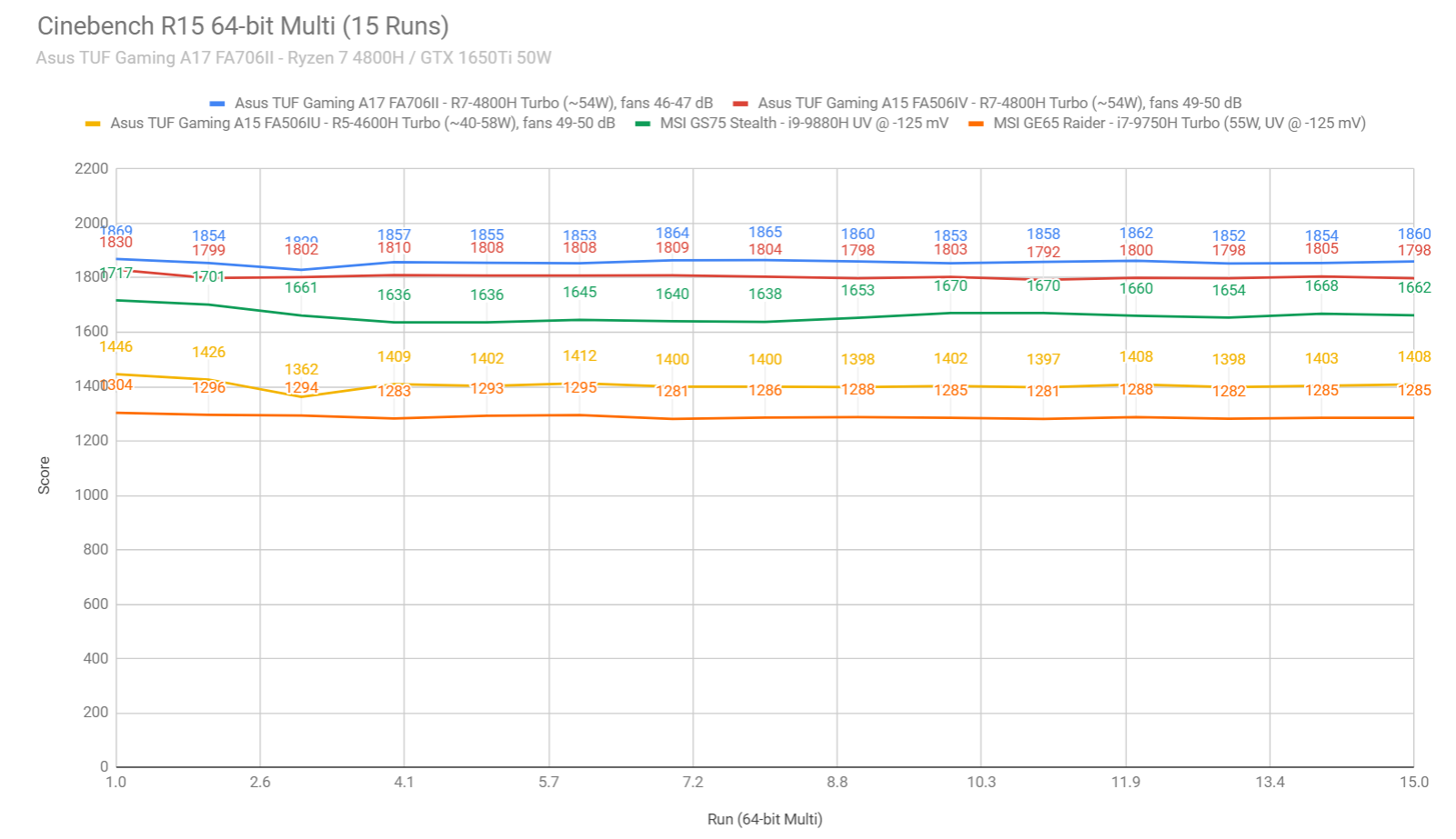
It’s worth noting that our findings are very similar to those on the 15-inch TUF Gaming FA506, with a slight increase in scores and decrease in temperatures and noise levels for the larger 17-inch model. That might seem normal at a first glance, given how this is a larger device, but then you also have to consider that it gets a lower-tier thermal module with smaller fans and fewer heatpipes. That suggests we somehow got lucky with this sample, with either a superior Ryzen 7 bin or perhaps better pasting. That means there might be a slight variation in this same test with retail FA706s, as this implementation did a little better than most.
We also ran the longer Cinebench R20 test in a loop to verify our findings above. The results are available below.
Finally, we also ran the Prime95 stress test on the Turbo profile, to measure the CPU’s behavior in an unrealistic 100% load on all cores.
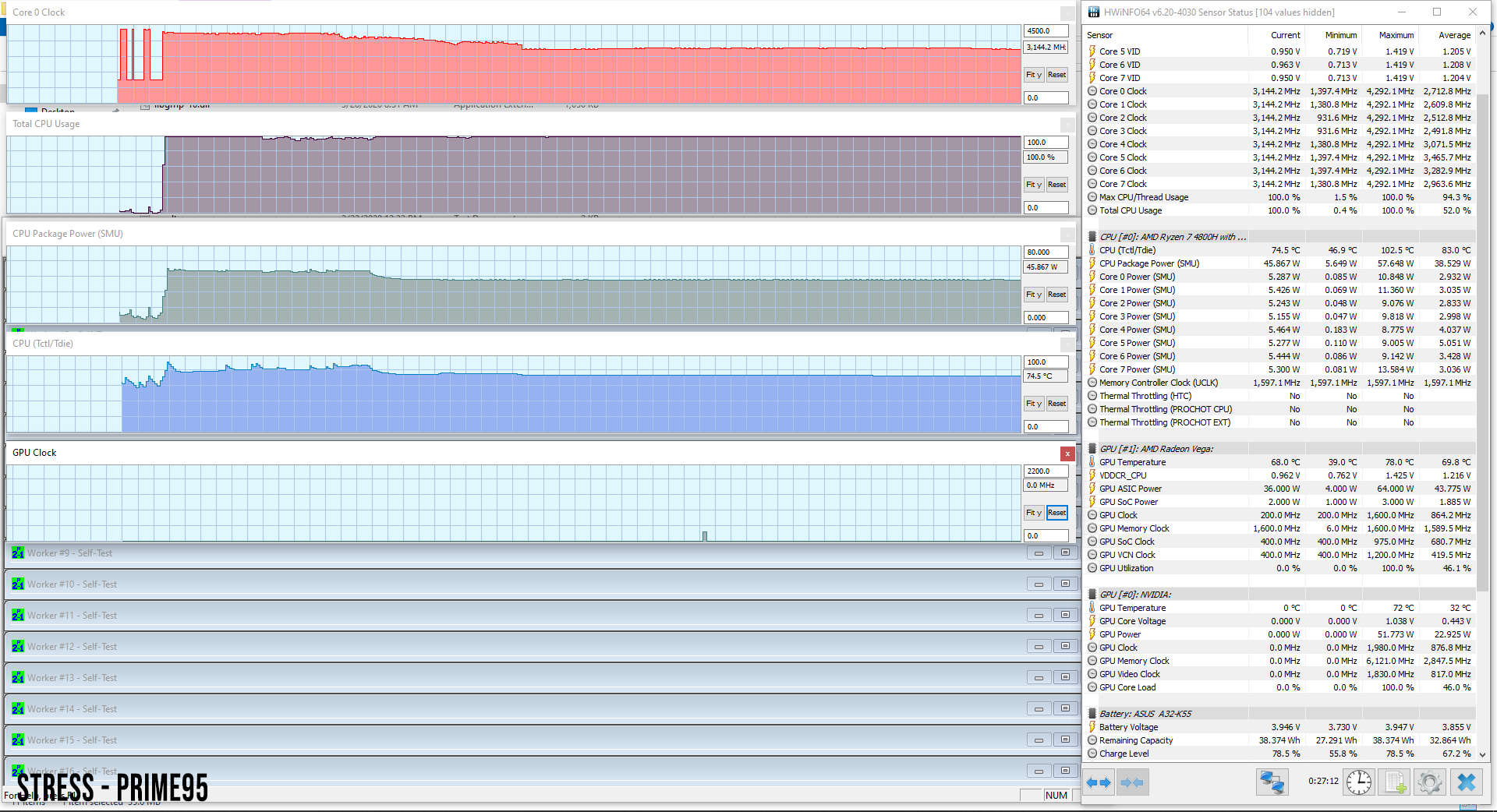
Next, we ran some of our combined CPU+GPU stress tests on this notebook. 3DMark stress runs the same test for 20 times in a loop and looks for performance variation and degradation over time, and this unit passed it with flying colors. Luxmark 3.1, on the other hand, fully loads both the CPU and GPU at the same time, however, the CPU is not properly logged by this test, but both components work the way they should.
Next, we’ve run the entire suite of tests and benchmarks, first of all on the Performance profile in Armoury Crate.
- 3DMark 13 – Fire Strike: 9495 (Graphics – 10210, Physics – 21912);
- 3DMark 13 – Time Spy: 4066 (Graphics – 3708, CPU – 9006);
- Uniengine Superposition – 1080p Extreme: 1985;
- Uniengine Superposition – 1080p Medium: 7303;
- Handbrake 1.3.1 (4K to 1080p encode): 43.20 average fps;
- GeekBench 4.4.2 64-bit: Single-Core: 5213, Multi-core: 31417;
- GeekBench 5.0.1 64-bit: Single-Core: 1194, Multi-core: 8343;
- CineBench R15 (best run): CPU 1708 cb, CPU Single Core 188 cb;
- CineBench R20 (best run): CPU 4015 cb, CPU Single Core 483 cb; ;
- x264 HD Benchmark 4.0 32-bit: Pass 1 – 221.56 fps, Pass 2 – 100.42 fps;
- x265 HD Benchmark 64-bit: 34.66 s.
Then we reran them on the Turbo profile.
- 3DMark 13 – Fire Strike: 9793 (Graphics – 10541, Physics – 22320);
- 3DMark 13 – Time Spy: 4228 (Graphics – 3850, CPU – 9533);
- Uniengine Superposition – 1080p Extreme: 2047;
- Uniengine Superposition – 1080p Medium: 7539;
- Handbrake 1.3.1 (4K to 1080p encode): 44.65 average fps;
- PassMark: Rating: 5744, CPU mark: 20950, 3D Graphics Mark: 8258;
- PCMark 10: 5421 (Essentials – 9649 , Productivity – 7245 , Digital Content Creation – 6101);
- GeekBench 4.4.2 64-bit: Single-Core: 5228, Multi-core: 31614;
- GeekBench 5.0.1 64-bit: Single-Core: 1198, Multi-core: 8370;
- CineBench R15 (best run): CPU 1860 cb, CPU Single Core 188 cb;
- CineBench R20 (best run): CPU 4249 cb, CPU Single Core 481 cb;
- x264 HD Benchmark 4.0 32-bit: Pass 1 – 220.59 fps, Pass 2 – 106.84 fps;
- x265 HD Benchmark 64-bit: 32.68 s.
Finally, we overclocked the GPU with MSI Afterburner (+150 MHz Core, + 1000 MHz Memory) and reran some of the graphics tests:
- 3DMark 13 – Fire Strike: 9982 (Graphics – 10758, Physics – 21776);
- 3DMark 13 – Time Spy: 4325 (Graphics – 3947, CPU – 9483);
- Uniengine Superposition – 1080p Extreme: 2114.
Just like on the FA506, the differences between the Turbo and Turbo OC profile are tiny, and that’s because the GPU is already overclocked (at +100 MHz Core/+120 Mhz Memory) on the default Turbo profile. These differences get even smaller with real games.
Furthermore, we also ran some Workstation related loads, on the default Performance and Turbo profiles:
- Blender 2.82 – BMW Car scene- CPU Compute: 3m 32s (Performance), 3m 18s (Turbo);
- Blender 2.82 – BMW Car scene- GPU Compute: 2m 17s (CUDA);
- Blender 2.82 – Classroom scene – CPU Compute: 11m 14s (Performance), 10m 21s (Turbo);
- Blender 2.82 – Classroom scene – GPU Compute: 8m 8s (CUDA);
- Luxmark 3.1 – Luxball HDR – OpenCL CPUs + GPUs score: CPU Not Supported;
- SPECviewerf 13 – 3DSMax: 104.08 (Turbo);
- SPECviewerf 13 – Catia: 67.04 (Turbo);
- SPECviewerf 13 – Creo: 90.17 (Turbo);
- SPECviewerf 13 – Energy: 7.59 (Turbo);
- SPECviewerf 13 – Maya: 122.49 (Turbo);
- SPECviewerf 13 – Medical: 28.95 (Turbo);
- SPECviewerf 13 – Showcase: 52.46 (Turbo);
- SPECviewerf 13 – SNX: 12.35 (Turbo);
- SPECviewerf 13 – SW: 62.09 (Turbo).
These are some excellent results on the CPU heavy tests, better than when we got on the smaller FA506, just like suggested by the Cinebench loop test. The lower-tier GPU does drop some of the results down in the more complex loads.
Anyway, with these out of the way, let’s look at some games. We ran a couple of DX11, DX12 and Vulkan titles on the default Turbo/Silent and on the Turbo + Overclocked GPU profiles. Here’s what we got:
FHD Turbo
FHD Turbo OC
FHD Silent
Battlefield V (DX 12, Ultra Preset, Ray-Tracing OFF)
58-64 fps
58-66 fps
54-60 fps
Far Cry 5 (DX 11, Ultra Preset, SMAA)
62 fps
64 fps
54 fps
Middle Earth: Shadow of Mordor (DX 11, Ultra Preset)
102 fps
104 fps
88 fps
Red Dead Redemption 2 (DX 12, Ultra Optimized, TAA)
44 fps
44 fps
37 fps
Rise of Tomb Raider (DX 12, Very High Preset, FXAA)
66 fps
68 fps
64 fps
Shadow of Tomb Raider (DX 12, Highest Preset, TAA)
49 fps
50 fps
48 fps
Strange Brigade (Vulkan, Ultra Preset)
74 fps
76 fps
71 fps
The Witcher 3: Wild Hunt (DX 11, Ultra Preset, Hairworks On 4)
40-62 fps
40-64 fps
32-56 fps
- Battlefield V, The Witcher 3 – recorded with Fraps/in-game FPS counter in campaign mode;
- Far Cry 5, Middle Earth, Strange Brigade, Red Dead Redemption 2, Tomb Raider games – recorded with the included Benchmark utilities;
- Red Dead Redemption 2 Optimized profile based on these settings.
While the OC profile showed a slight increase in the GPU benchmarks results, the real-life results in games are merely identical between the Turbo and Turbo OC profiles.
The HWinfo logs below show the CPU and GPU speeds and temperatures in Farcry 5, Shadow of Mordor and Witcher 3 on the stock Turbo profile, which ramps up the fans to about 47-48 dB at head level on our review unit (47 dB displayed in Armour Crate).
Overclocking the GPU has almost no impact on the GPU’s average clock speeds or temperatures, hence the results above.
Raising the laptop from the desk doesn’t help either on this model, unlike on the hotter-running A15 FA506IV.
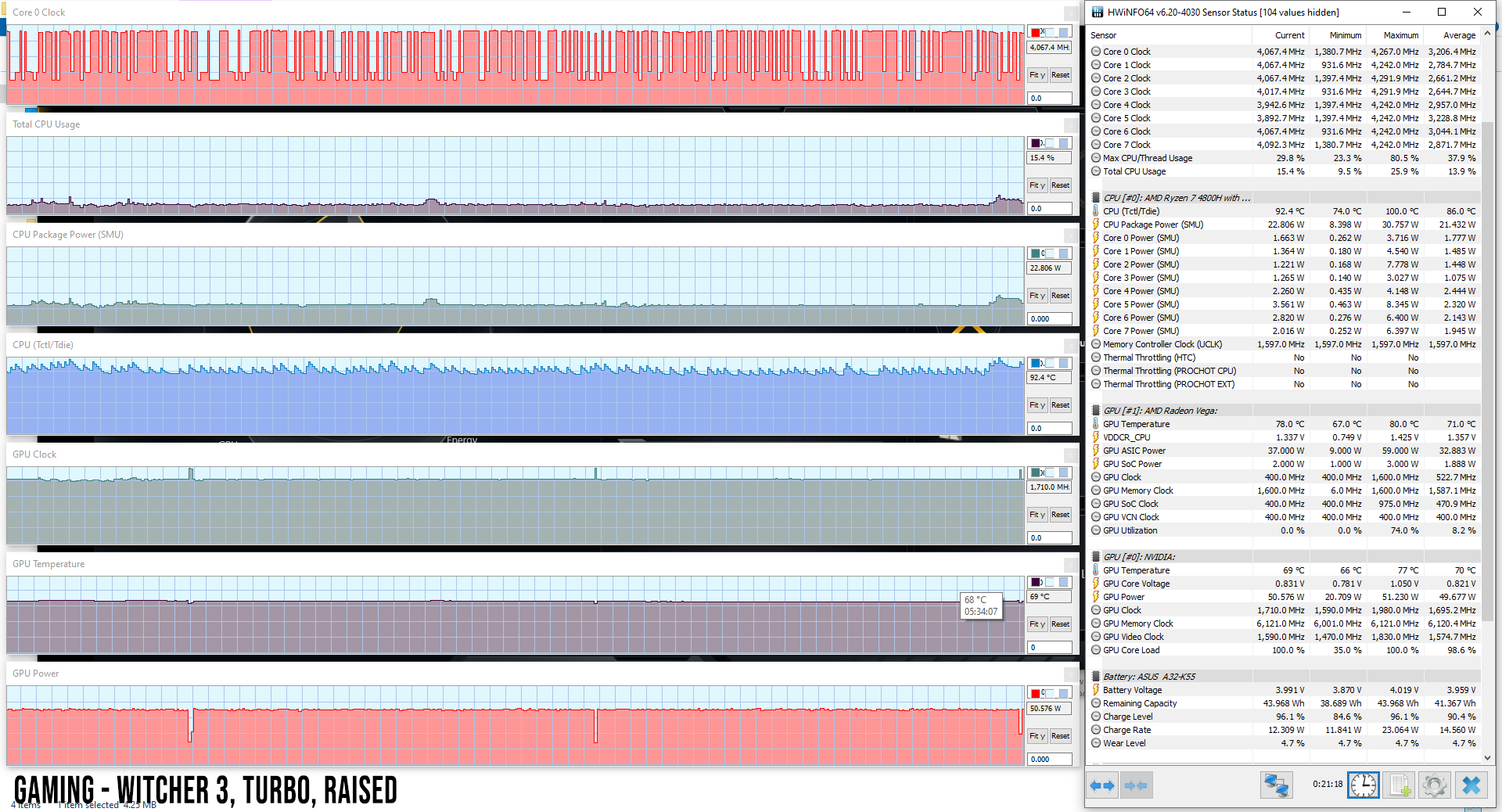
Gaming on the Performance profile tames down the fans to about 44-45 dB at head level (44 dB in Armoury Crate), without any significant dip in CPU/GPU frequencies, as the thermal module is able to keep temperatures at bay on this configuration. In comparison, the 90W RTX 2060 powered FA506 showed an increase in temperatures and decrease in performance on this profile, and I’d expect about the same for the more powerful 1660Ti version of the FA706.
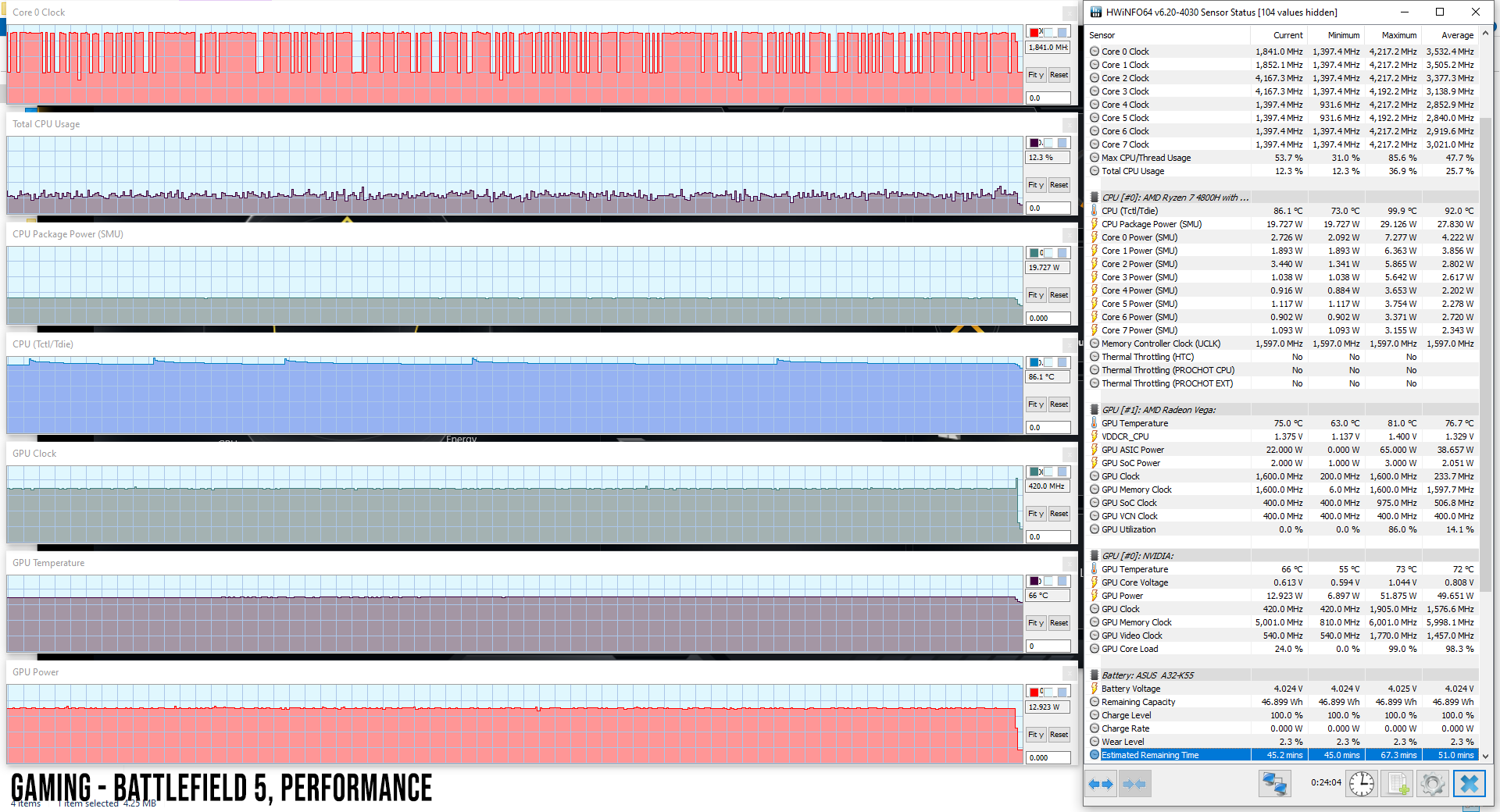
Gaming on Silent further quiets down the fans to barely audible levels of about 35-37 dB at head-level (26 dB in Armory Crate), but also limits the performance of the CPU (limited to 12W), while the GPU still runs at 50W. Games are still running OK on this profile, but at reduced framerates due to the low-clocked CPU.
Finally, gaming on battery (on Performance) is also somewhat possible. In this case, though, the CPU is still limited at 12 W and the GPU is also limited at 30W, so the performance takes a dip. This is different than what we found on the FA506, which was actually more heavily limited on Silent/Plugged-in than on Performance/Unplugged, so I’d look into more review if these aspects matter to you.
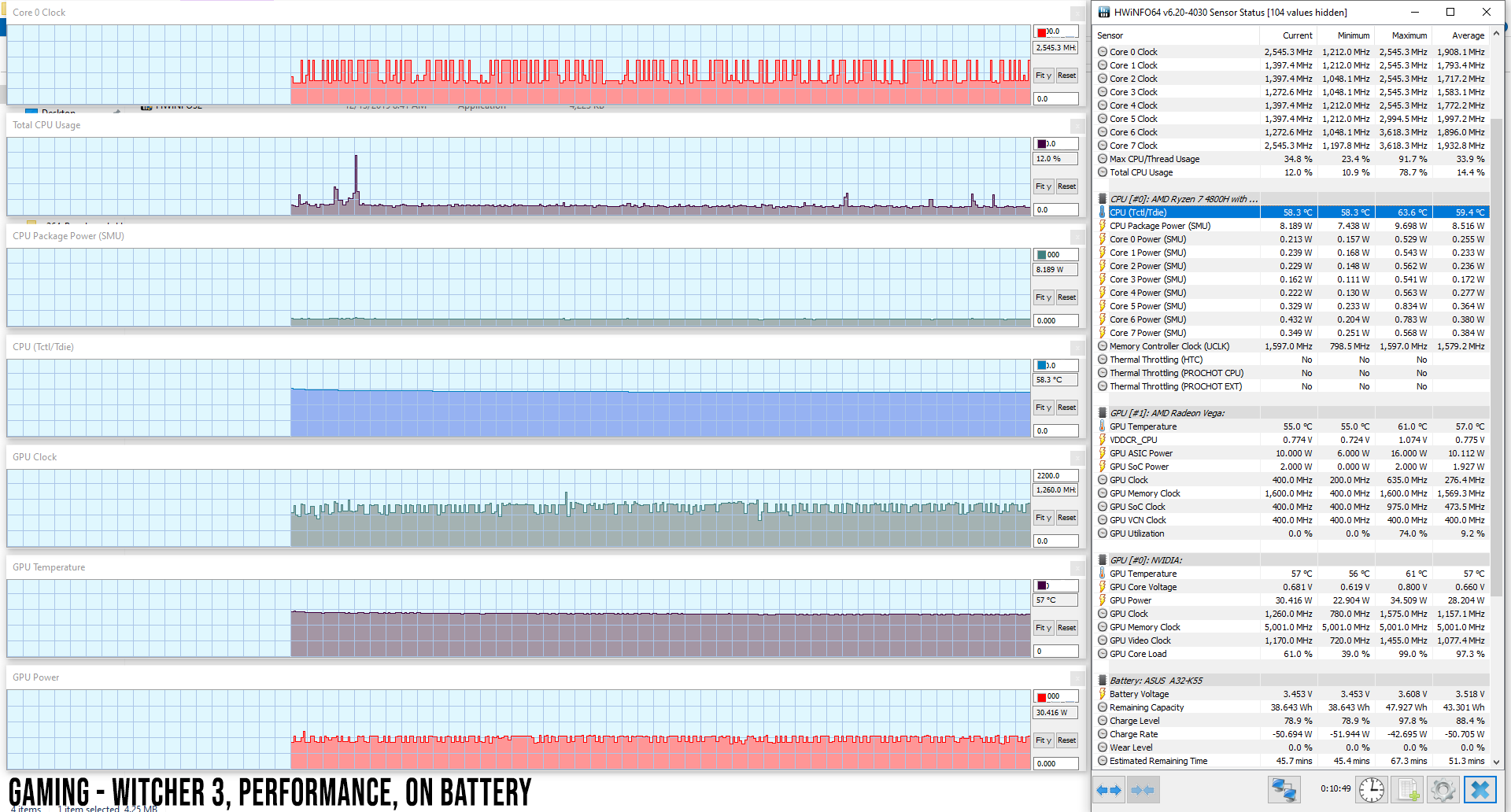
Drawing the line, this TUF Gaming FA706II is a solid performer in CPU loads, but limited by the lower-tier GPU in games and complex tasks. That’s why I’d rather opt for the GTX 1660Ti configuration alongside a Ryzen 7 processor, the two are better matched together, while the budget-oriented shoppers among you will find a good and affordable combo in the Ryzen 5 4600H + GTX 1650 Ti versions available in retail.
We’ll pitch the two versions side by side in a future article, as well as compare the FA706 with the previous FX705 models which are most likely available at discounts these days.
Noise, Heat, Connectivity, speakers, and others
The GTX 1650Ti TUF Gaming FA706II gets a fairly basic thermal module, with smaller fans and fewer heatpipes than the higher tier 1660Ti/2060 implementations. For the most part, though, this is still perfectly capable of keeping a Ryzen 7 4800H + GTX 1650Ti configuration in check.
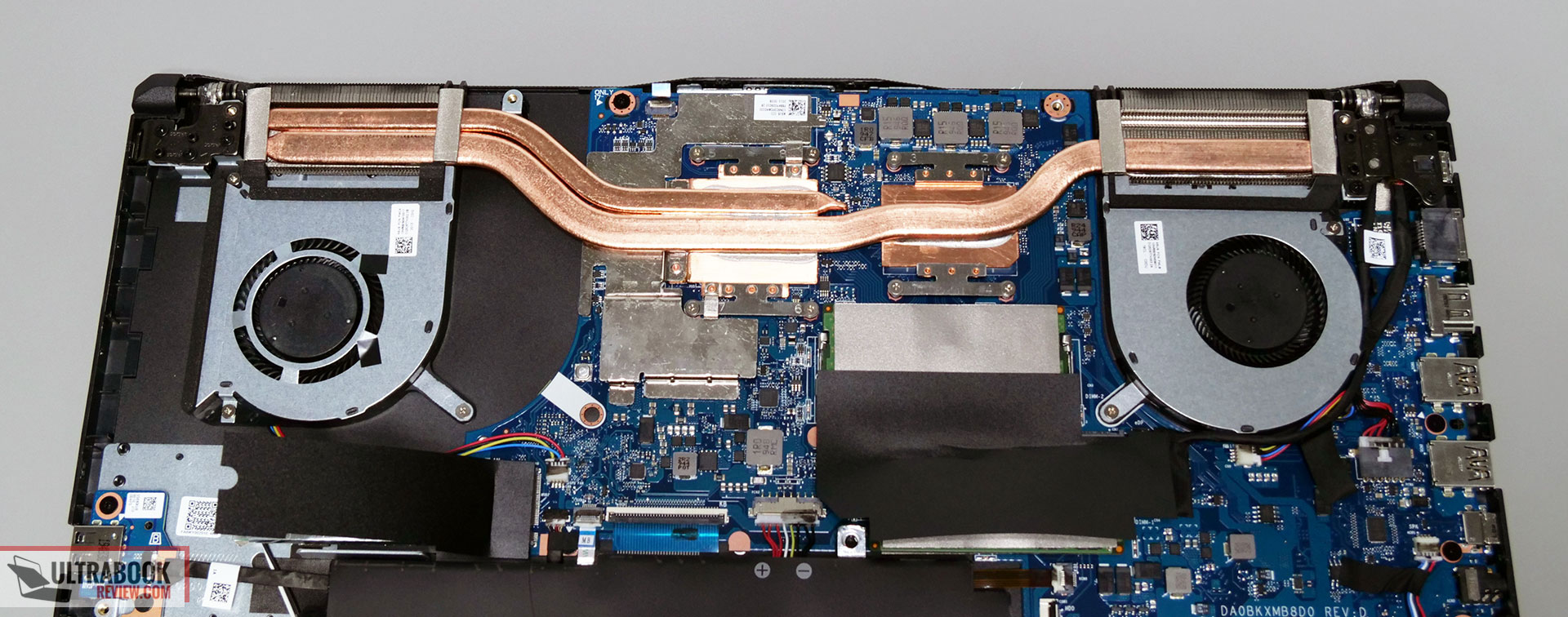
The CPU still runs hot with games on this notebook, averaging 88-95 degrees on Turbo in the more demanding titles. The GPU, on the other hand, averaged about 68-70 degrees on Turbo in the various titles we’ve tested.
These internal temperatures barely spread onto the outer shell. Certain parts of the underbelly, around the CPU exhaust, reach temperatures in the high 40s, or low 50s if you opt to play games on Silent. However, the interior and keyboard deck barely go up to low and mid-40s, which is perfectly comfortable for long gaming sessions.
As far as fan-noise goes, here’s what we got:
- Turbo – 47-48 dB with games (47 dB Armoury Crate), 46-47 dB with Cinebench loop test;
- Performance – 44-45 dB with games (44 dB Armoury Crate), 38-39 dB with Cinebench loop test;
- Silent – 35-38 dB with games (33 dB Armoury Crate), 30-32 dB with Cinebench loop test.
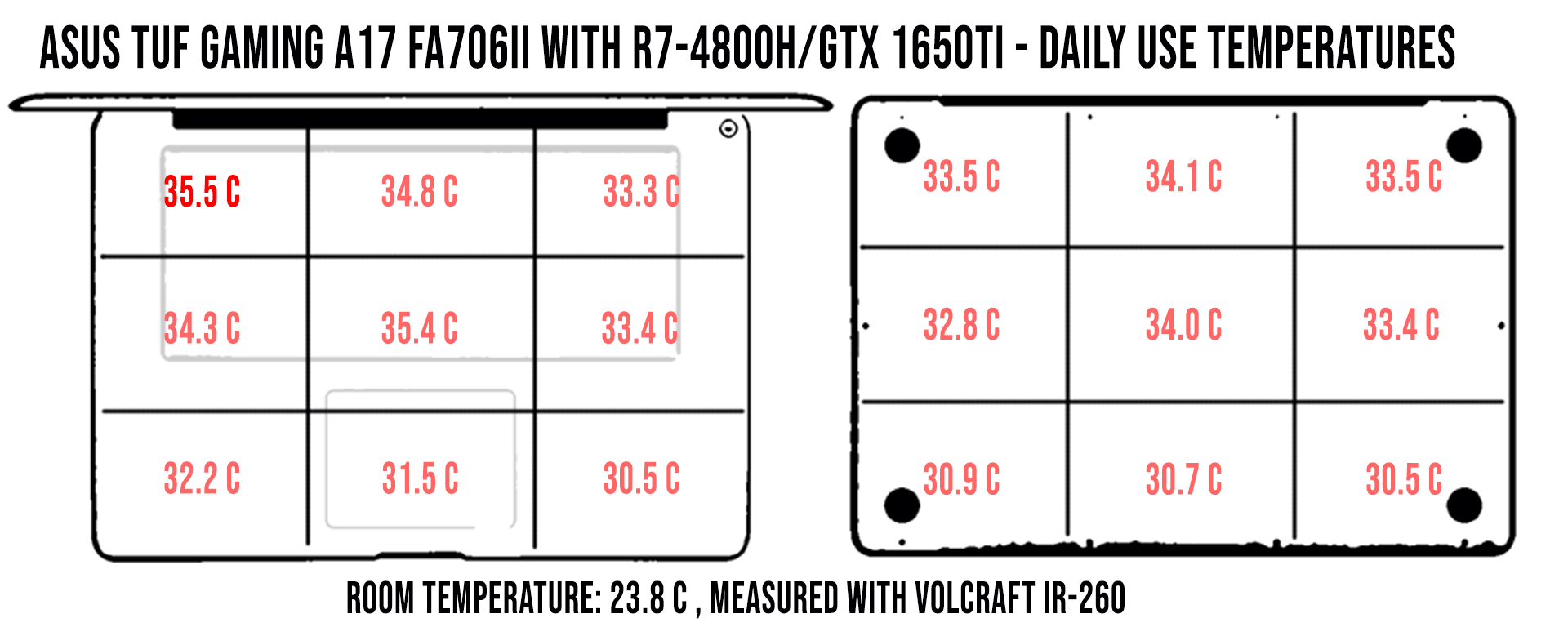
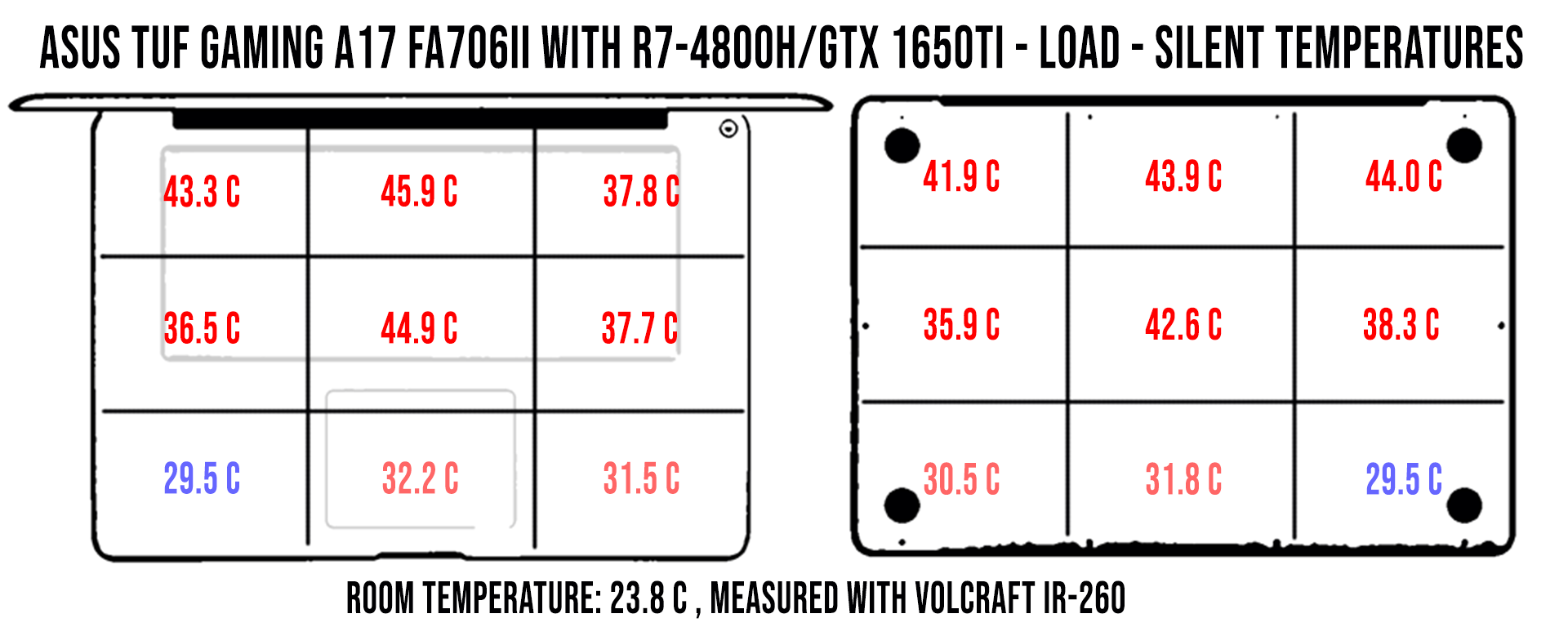
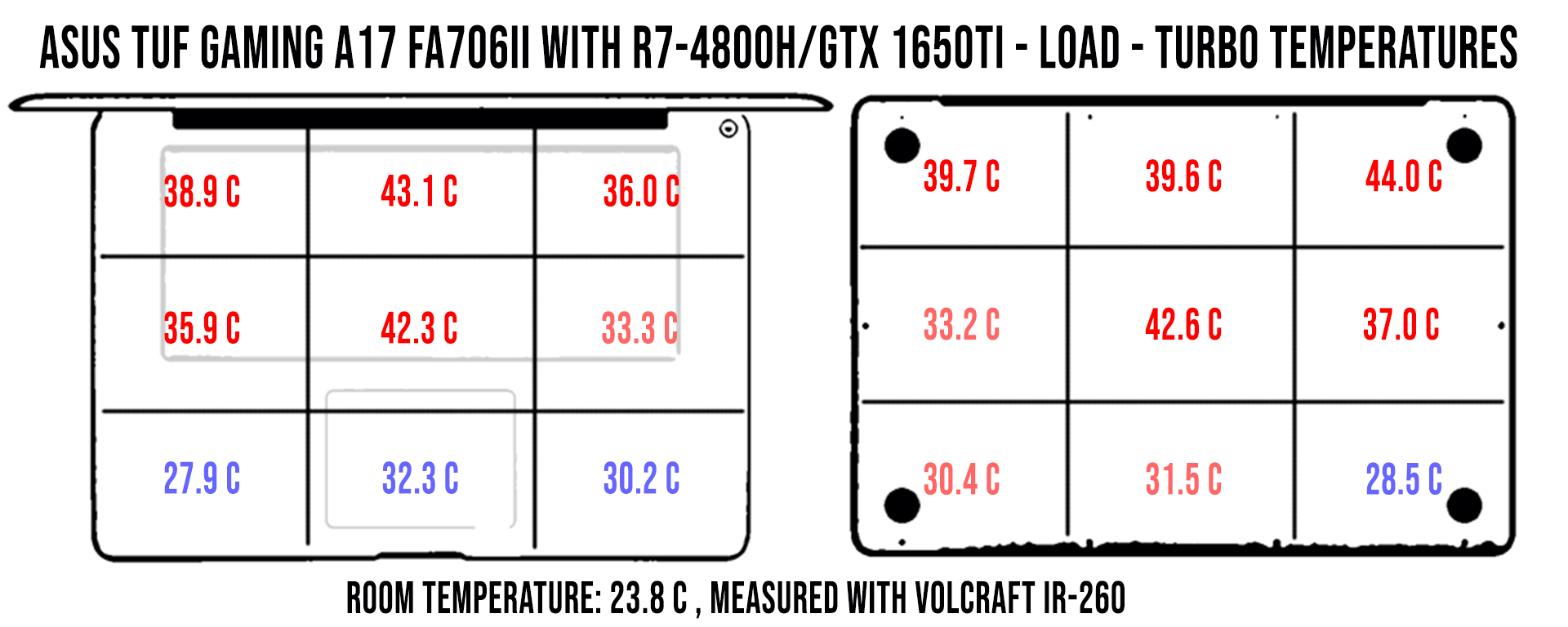
*Daily Use – streaming Netflix in EDGE for 30 minutes, Silent Profile, fans at 30-33 dB (22 dB in Armoury Crate)
*Gaming – Turbo– playing Far Cry 5 for 30 minutes, Turbo Profile, fans at 47-48 dB (47 dB in Armoury Crate)
*Gaming – Silent– playing Far Cry 5 for 30 minutes, Silent Profile, fans at 35-38 dB (33 dB in Armoury Crate)
For connectivity, there’s Gigabit Lan and Wireless AC through Realtek chips on this unit. We’ve mostly used the laptop on wireless, and it performed well both near the router and at 30+ feet away with obstacles in between, without drops or other issues. However, higher-tier WiFi 6 notebooks were able to reach higher speeds with our setup.
The speakers are an upgraded version of what Asus used on the previous TUF series. The documentation mention 1.8x louder and 2.6x deeper bass. I can attest to the slightly richer sound with improved bass, but the volume still tops at middling rates of around 75-77 dB. The audio jack seems pretty good, though, so you’ll most likely want to hook up some headphones to cover the fan noise in games.
Finally, the camera is placed on top of the screen, flanked by microphones. It’s OK for occasional calls, but laggy and grainy, so don’t expect much.
Battery life
There’s a 48Wh battery inside this TUF Gaming A17 configuration. Asus offers the series with either a 48 Wh (and HDD cage) or a 90 Wh battery, and I’d recommend opting for the latter, which is mostly what you’ll find on the FA706IU models.
With that in mind, though, here’s what we got on our review unit, with the screen’s brightness set at around 120 nits (~70 brightness).
- 11 W (~4+ h of use) – text editing in Google Drive, Silent Mode, screen at 70%, Wi-Fi ON;
- 9.5 W (~5- h of use) – 1080p fullscreen video on Youtube in Edge, Silent Mode, screen at 70%, Wi-Fi ON;
- 9.8 W (~5- h of use) – Netflix fullscreen in Edge, Silent Mode, screen at 70%, Wi-Fi ON;
- 24 W (~2h of use) – browsing in Edge, Performance Mode, screen at 70%, Wi-Fi ON;
- 51 W (~50 min of use) – Gaming – Witcher 3, Performance Mode, screen at 70%, Wi-Fi ON, no fps limit.
This TUF A17 configuration comes with a mid-sized 180W power-brick, and that’s what you’ll also get with the GTX 1660Ti models. The battery fills up in about 2 hours and USB-C charging is not supported.
Price and availability
The TUF Gaming A17 FA706 is now listed in most regions at the time of this article, with availability scheduled for the next few weeks.
The GTX 1650Ti configuration reviewed here is not yet available, so we’ll update once we know more. I’d expect it to start at around $800-$900 with the Rzyen 5 processor.
However, the TUF A17 FA706IU model with a Ryzen 7 4800H / GTX 1660Ti is available for $1099 in the US, and around 1299 GBP in the UK, with 16 GB of dual-channel RAM and 1 TB of storage. That’s competitive and just slightly more expensive than the similarly specced 15-inch A15, but it does get twice the amount of storage out of the box.
Follow this link for the latest updated prices and configurations available in your region.
Final thoughts
I’ve said it before and I’m going to say it again: Asus did a good job with these updated TUF Gaming laptops and I’m confident they’re going to be highly popular throughout 2020 in their niches.
The performance is CPU demanding loads, paired with competitive pricing, are the TUF A17’s major selling points. The FA706II reviewed here is a good allrounder and can handle FHD gaming at medium settings, while the FA706IU is the even better value pick for productivity and gaming. Too bad that 120 Hz screen is dim and washed out, though, I would have hoped for an upgrade on this generation, just like on the 15-inch series.
That’s one of the important reasons why I prefer the TUF A15 over this A17 variant. The other is its more compact size and slightly more affordable pricing, as well as the option for the more powerful RTX 2060 GPU, which is not available for this 17-inch model. The A17 does offer a larger screen though, which might be enough to steer you towards its side, and it might also run slightly cooler with games on the GTX 1660Ti configuration, which might matter on this platform that tends to reach high temperatures quickly.
This wraps up our review of the Asus TUF Gaming A17 FA706II, but I’d love to hear your feedback down below, so get in touch if you have anything to share or any questions about this gaming notebook.
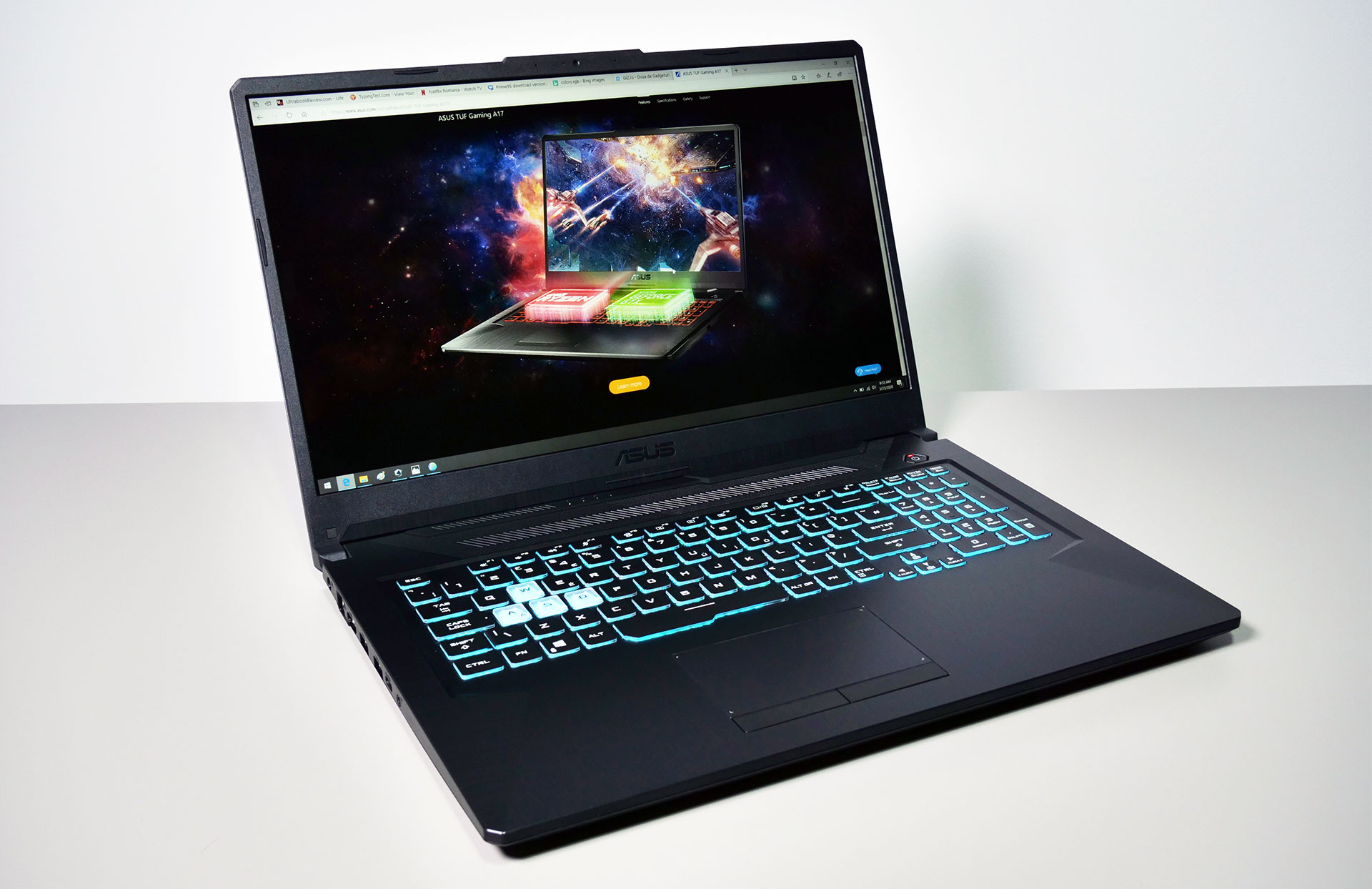
Disclaimer: Our content is reader-supported. If you buy through some of the links on our site, we may earn a commission.
Navigation: Ultrabookreview.com » 15.6 inch or larger
Our content is reader-supported. If you buy through some of the links on our site, we may earn a commission. Terms


Review by: Andrei Girbea
Andrei Girbea, Editor-in-Chief. I’ve a Bachelor’s in Computer Engineering and I’ve been covering mobile technology since the 2000s. You’ll mostly find reviews and thorough guides written by me here on the site, as well as some occasional first-impression articles.
. I’ve a Bachelor’s in Computer Engineering and I’ve been covering mobile technology since the 2000s. You’ll mostly find reviews and thorough guides written by me here on the site, as well as some occasional first-impression articles.





